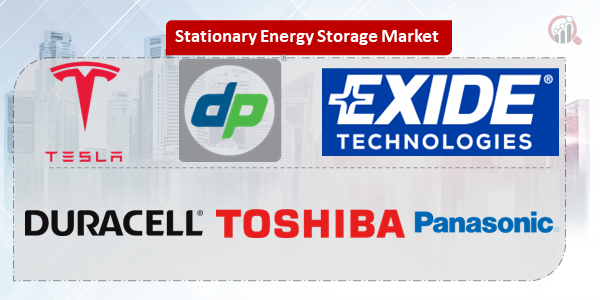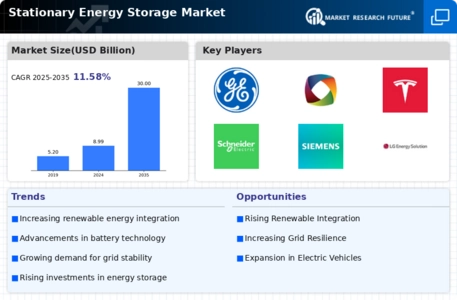Top Industry Leaders in the Stationary Energy Storage Market

*Disclaimer: List of key companies in no particular order
Top listed global companies in the Stationary Energy Storage industry are:
Tesla
Durapower
Exide Technologies
Duracell
Toshiba Corporation
Panasonic Corporation
Samsung SDI
Johnson Controls
Philips
Hoppecke Batteries
Bridging the Gap by Exploring the Competitive Landscape of the Stationary Energy Storage Top Players
The stationary energy storage market is experiencing explosive growth, propelled by the rise of renewable energy, grid modernization efforts, and increasing demand for energy resilience. This dynamic landscape boasts a diverse range of players, each implementing unique strategies to capture market share. Let's delve into the key actors, their approaches, and the current competitive panorama.
Dominant Players and Established Strategies:
Tesla: The undisputed leader, Tesla leverages its brand recognition and vertically integrated approach, encompassing battery production, power electronics, and software. By offering integrated energy solutions (solar panels, Powerwalls), they cater to both residential and commercial segments.
Samsung SDI and LG Chem: These South Korean giants capitalize on their expertise in lithium-ion battery manufacturing, supplying cells and modules to other players. They are actively researching next-generation battery technologies like solid-state batteries to maintain their edge.
BYD: China's BYD excels in offering cost-competitive solutions by vertically integrating its entire value chain, from materials to finished systems. They target both utility-scale and commercial applications, particularly in their domestic market.
Factors Shaping Market Share Analysis:
Technology Leadership: Innovation in battery chemistry, power conversion systems, and software intelligence play a crucial role in differentiating offerings. Companies investing heavily in R&D gain a competitive advantage.
Project Portfolio and Execution: Securing large-scale utility and commercial contracts and delivering projects efficiently and on time establish a player's track record and build trust.
Cost Competitiveness: Offering cost-effective solutions, particularly for larger installations, is crucial for winning bids and expanding market reach. Economies of scale and vertical integration play a vital role.
Geographical Focus: Understanding regional nuances in regulations, grid infrastructure, and customer preferences is essential for successful market penetration. Players strategically allocate resources to targeted regions.
Emerging Trends and Company Strategies:
Second-Life Batteries: Repurposing batteries from electric vehicles for stationary storage offers a sustainable and cost-effective solution. Startups like Redwood Materials and Tesla are leading the charge in this space.
Virtual Power Plants and Grid Services: Aggregating distributed energy resources, including home batteries, to provide grid support services like peak shaving and frequency regulation is gaining traction. Companies like sonnen and Stem are paving the way in this area.
Microgrids and Islanding Capabilities: Building self-sufficient energy systems, particularly for remote or disaster-prone areas, is a growing trend. Companies like sonnen and Schneider Electric are offering microgrid solutions tailored to specific needs.
Overall Competitive Scenario:
The stationary energy storage market is characterized by intense competition, with established players battling for market share and new entrants constantly bringing innovation to the table. Collaboration and partnerships are becoming increasingly common, with companies recognizing the value of combining expertise and resources. The focus is shifting towards offering complete energy solutions, encompassing storage, software management, and grid integration services. Sustainability and circular economy principles are gaining traction, influencing both technology development and business models. The market is expected to remain highly dynamic in the coming years, driven by the global clean energy transition and technological advancements.
In conclusion, the competitive landscape of the stationary energy storage market is a fascinating battleground, teeming with diverse players, evolving strategies, and groundbreaking technologies. Understanding the key factors driving market share and the emerging trends shaping the future will be crucial for both established players and newcomers aiming to thrive in this rapidly growing market.
Latest Company Updates:
Tesla:
- Master plan forecast: Predicts around 46,200 GWh of stationary storage needed in the next 20 years (source: Tesla Master Plan, Part 3).
Durapower:
- Focused on commercial & industrial (C&I) market: Launched new 500V DuraPack Pro LFP system for C&I applications, offering cost-efficiency and safety (source: Durapower press release, October 18, 2023).
Exide Technologies:
- Expansion in residential energy storage: Acquired Sunverge Energy, a leading provider of residential solar storage solutions, in July 2023 (source: Exide Technologies press release, July 12, 2023).
Toshiba Corporation:
- Strong presence in Japan: Leading player in Japan's energy storage market, with focus on lithium-ion and redox flow battery technologies (source: Toshiba website, Energy Solutions).

